FINDING AREA AND PERIMETER OF A PARALLELOGRAM
Subscribe to our ▶️ YouTube channel 🔴 for the latest videos, updates, and tips.
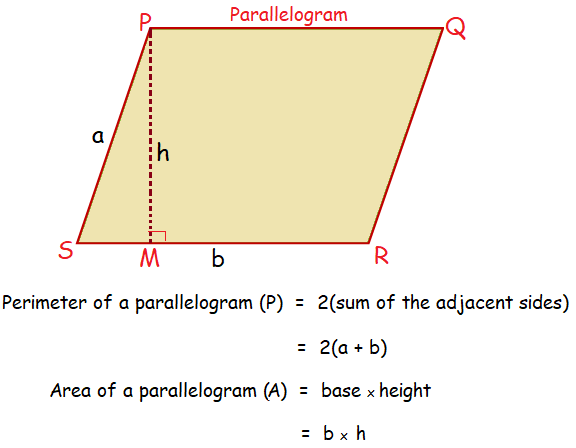
Find the area and perimeter of the following parallelograms :
Problem 1 :
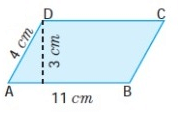
Solution :
From the figure,
Base of a parallelogram (b) = 11 cm
Height of a parallelogram (h) = 3 cm
Then,
Area of the parallelogram = b x h sq. units.
Area = 11 x 3
So, area of the parallelogram = 33 sq. cm.
Perimeter of the parallelogram = sum of the length of the four sides.
= 11 cm + 4 cm + 11 cm + 4 cm
So, perimeter of the parallelogram = 30 cm
Problem 2 :
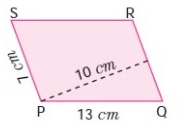
Solution :
From the figure,
Base of a parallelogram (b) = 7 cm
Height of a parallelogram (h) = 10 cm
Then,
Area of the parallelogram = b x h sq. units.
Area = 7 x 10
So, area of the parallelogram = 70 sq. cm.
Perimeter of the parallelogram = sum of the length of the four sides.
= 13 cm + 7 cm + 13 cm + 7 cm
= 40 cm
Problem 3 :
Find the missing values.

Solution :
(i)
Base of a parallelogram (b) = 18 cm
Height of a parallelogram (h) = 5 cm
Then,
Area of the parallelogram = b x h sq. units.
Area = 18 x 5
So, area of the parallelogram = 90 sq. cm.
(ii)
Base of a parallelogram (b) = 8 m
Area of the parallelogram = 56 sq. m
Then,
Area of the parallelogram = b x h sq. units.
56 = 8 x h
56/8 = h
7 m = h
So, height of a parallelogram (h) = 7 m
(iii)
Height of a parallelogram (h) = 17 mm
Area of the parallelogram = 221 sq. mm
Area of the parallelogram = b x h sq. units.
221 = b x 17
221/17 = b
13 mm = b
So, base of a parallelogram (b) = 13 mm.
Problem 4 :
Suresh won a parallelogram – shaped trophy in a state level chess tournament. He knows that the area of the trophy is 735 sq. cm and its base is 21 cm. what is the height of that trophy?
Solution :
Given,
Base of the trophy (b) = 21 cm
Area of the trophy = 735 sq.cm
Area of the parallelogram = b x h sq. units.
735 = 21 x h
735/21 = h
35 cm = h
So, height of trophy (h) = 35 cm
Problem 5 :
Janaki has a piece of fabric in the shape of a parallelogram. Its height is 12 m and its base is 18 m. She cuts the fabric into four equal parallelograms by cutting the parallel sides through its mid – points. Find the area of each new parallelogram.
Solution :
Given,
Base of a parallelogram (b) = 18 m
Height of a parallelogram (h) = 12 m
Area of the parallelogram = b x h sq. units.
= 18 m x 12 m
= 216 m2
Since she cuts the fabric into four equal parallelograms,
= 216/4
= 54 m2
So, the area of each new parallelogram = 54 m2.
Problem 6 :
A ground is in the shape of parallelogram. The height of the parallelogram is 14 meters and the corresponding base is 8 meters longer than its height. Find the cost of levelling the ground at the rate of $ 15 per sq. m.
Solution :
Given,
Base of a parallelogram (b) = 8 m
Since base is 8 meters longer than height,
Now, base = (14 + 8) = 22 m
Height of a parallelogram (h) = 14 m
Area of the parallelogram = b x h sq. units.
= 22 m x 14 m
= 308 m2
Cost of levelling 1 m2 = 15 per sq. m.
Cost of levelling 308 m2 = 308 x 15
= $ 4,620
So, the cost of levelling the ground = $ 4,620
Problem 7 :
The logo below is created by joining two congruent parallelograms. Calculate the area of the logo.
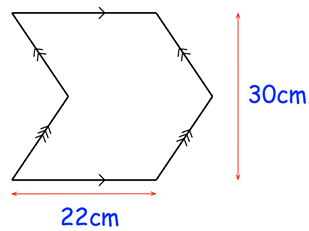
Solution :
Base of parallelogram = 22 cm
height = 30 cm, height of parallelogram = 15 cm
Area of logo = 2 (area of parallelogram)
= 2(base x height)
= 2(22 x 15)
= 660 cm2
Problem 8 :
Find x .
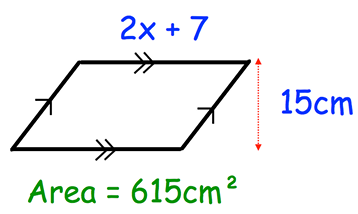
Solution :
Area of parallelogram = 615 cm2
base = 2x + 7, height = 15 cm
(2x + 7) 15 = 615
2x + 7 = 615 / 15
2x + 7 = 41
2x = 41 - 7
2x = 34
x = 34/2
x = 17
So, the value of x is 17.
Problem 9 :
A shape is made from 4 congruent parallelograms. The area of the shape is 792cm²
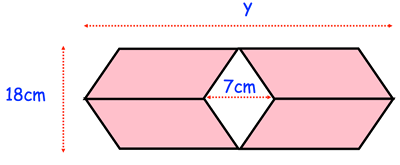
Solution :
height of one parallelogram = 18/2 ==> 9 cm
base = (y - 7)/2
Area of 4 congruent parallelograms = 4 (base x height)
= 4 (9 x (y - 7)/2)
= 18(y - 7)
area of the shape = 792 cm²
18(y - 7) = 792
y - 7 = 792/18
y - 7 = 44
y = 44 + 7
y = 51 cm
So, the value of y is 51 cm.
Problem 10 :
If three consecutive vertices of a parallelogram ABCD are A(1, -2), B(3, 6) and C (5, 10), find its fourth vertex D.
Solution :
In a parallelogram, opposite sides will be equal.
Midpoint of the diagonals will be equal. Let (x, y) be the fourth vertex.
Midpoint of diagonal AC = (x1 + x2)/2, (y1 + y2)/2
= (1 + 5)/2, (-2 + 10)/2
= 6/2, 8/2
= (3, 4)
Midpoint of diagonal BD = (x1 + x)/2, (y1 + y)/2
(3 + x)/2, (6 + y)/2 = (3, 4)
|
(3 + x)/2 = 3 3 + x = 6 x = 6 - 3 x = 3 |
(6 + y)/2 = 4 6 + y = 8 y = 8 - 6 y = 2 |
So, the required fourth vertex is at (3, 2).
Subscribe to our ▶️ YouTube channel 🔴 for the latest videos, updates, and tips.
Kindly mail your feedback to v4formath@gmail.com
We always appreciate your feedback.
About Us | Contact Us | Privacy Policy
©All rights reserved. onlinemath4all.com
Recent Articles
-
Coin Tossing Probability
Dec 13, 25 10:11 AM
Coin Tossing Probability - Concept - Sample Space - Formula - Solved Problems -
10 Hard SAT Math Questions (Part - 39)
Dec 11, 25 05:59 PM
10 Hard SAT Math Questions (Part - 39) -
10 Hard SAT Math Questions (Part - 38)
Dec 08, 25 12:12 AM
10 Hard SAT Math Questions (Part - 38)
